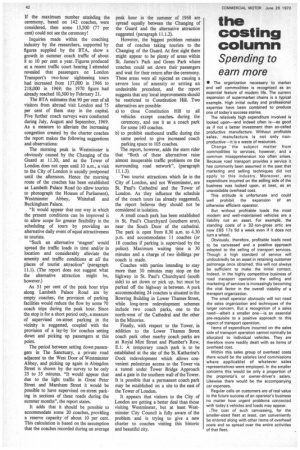the costing column
Page 44

If you've noticed an error in this article please click here to report it so we can fix it.
Spending to earn more
• The organization necessary to market and sell commodities is recognized as an essential feature of modern life. The current expansion of supermarket chains is a typical example. High initial outlay and professional expertise have been combined to produce one of today's success stories.
The relatively high expenditure involved is looked upon—and indeed often is—as good as if not a better investment than so-called productive manufacture. Without profitable sales, manufacture is not only nonproductive—it is a waste of resources.
Change the subject matter from commodities to services, however, and a common misapprehension too often arises. Because road transport provides a service it has commonly been assumed in the past that marketing and selling techniques did not apply to this industry. Moreover, any expenditure incurred on the selling side of the business was looked upon, at best, as an unavoidable overhead cost.
This attitude is unfortunate and could well prohibit the expansion of an otherwise efficient operator.
But without profitable loads the most modern and well-maintained vehicles are a liability not an asset. For example, the standing costs of a 32-ton-gross artic are now £65 17s 9d a week even if it does not turn a wheel.
Obviously, therefore, profitable loads need to be canvassed and a positive approach adopted to the selling of transport services. Though a high standard of service will undoubtedly be an asset in retaining customer patronage once obtained, this will not always be sufficient to make the initial contact. Indeed, in the highly competitive business of road transport operation the selling and marketing of services is increasingly becoming the vital factor in the overall viability of a transport organization.
The small operator obviously will not need the sales organization and techniques of the larger concern. But a recognition of a sales need---albeit a smaller one—is art essential pre-requisite to a positive approach to this aspect of transport operation.
Items of expenditure incurred on the sales side of transport operation cannot normally be allocated to individual vehicles. They are therefore more readily dealt with as items of overhead cost.
Within this sales group of overhead costs there would be the salaries (and commissions where applicable) of whatever sales representatives were employed. In the smaller concerns this would be only a proportion of the proprietor's or owner-driver's salary. Likewise there would be the accompanying car expenses.
Regular calls on customers are of real value to the future success of an operator's business no matter how urgent problems connected with today's vehicles and loads may appear, . The cost of such canvassing, for the smaller-sized fleet at least, can conveniently be entered along with other items of overhead costs and so spread over the entire activities of that fleet.






















































































































